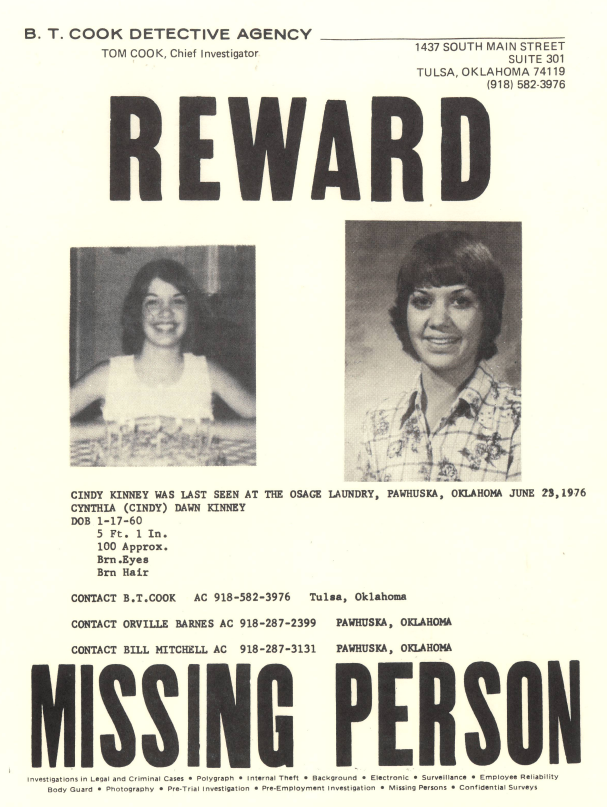This is an excerpt from our true crime newsletter, Suspicious Circumstances, which sends the biggest unsolved mysteries, white collar scandals, and captivating cases straight to your inbox every week. Sign up here.
Dennis Rader, the Wichita, Kansas, serial killer who dubbed himself BTK (for “bind, torture, kill”), really liked to write. In fact, it was his own notes and letters — rife with misspellings and grammatical errors — to the media and police that ultimately resulted in his capture. Now, 18 years after Rader was ordered to serve 10 consecutive life sentences for murdering 10 people from 1974 to 1991, investigators are finding potential clues to cold cases in the journals, notebooks, manuscripts and other documents seized after his arrest.
Some of those cold cases are now heating up: Authorities last week named Rader as the prime suspect in unsolved murders in Oklahoma and Missouri. As part of their investigation into the 1976 disappearance of 16-year-old cheerleader Cynthia Dawn Kinney in Pawhuska, Oklahoma, Osage County Sheriff’s officials on Aug. 23 dug up the property where Rader’s family home once stood in Park City, Kansas.
Authorities said they found incriminating evidence, including possible restraints and a “pantyhose ligature.” Osage County Undersheriff Gary Upton told HuffPost there were also “trophies” — which could lead to the identification of yet another victim.
“My hope in the future is to perhaps at least reveal a picture of one of those sets of items, because it obviously belongs to a female victim,” he said. “And I think somebody seeing it would perhaps know who it belonged to.”

Rader’s killings terrorized the Wichita area, a community that had known him as a seemingly ordinary family man. He appeared to be a devoted husband and was the father of two children. He was a Cub Scout leader and president of his church council. But he was also a sadistic murderer who for decades prowled the city for victims, stalking women, breaking into their homes and killing them — then stealing “tokens” like jewelry, identification cards, lingerie.
Rader’s various jobs took him outside the state of Kansas, and Osage County detectives now suspect he killed Shawna Beth Garber, a 22-year-old woman in McDonald County, Missouri. Garber was raped and restrained with different types of bindings — a BTK signature — before being strangled in 1990.
Upton told HuffPost that by looking at Rader’s journal entries and work history, among other things, investigators determined that at the time Garber was killed, Rader was in Missouri, working for the U.S. Census Bureau as an area supervisor.
Garber’s body was severely decomposed when it was found by an abandoned house in southwest Missouri. She had been considered missing for decades before her remains were identified using genetic genealogy in 2021. Upton said that investigators had found Polaroid photos in one of Rader’s journals showing items that “likely” belonged to Garber, including a red blanket that went missing when she disappeared.
Investigators believe another job Rader held and a journal entry link him to the disappearance of Kinney, who was last seen leaving the laundromat owned by her family. At the time, a bank across the street was installing a security system, authorities believe, and Rader worked for the security company ADT from 1974 to 1988.
In an Aug. 24 press release, the Osage County Sheriff’s Office shared an excerpt of a 1976 journal entry of Rader’s that it says “gives details on his whereabouts.”
“This journal entry alludes to a significant event marked as ‘PJ-Bad Wash Day’ during a period in which Rader acknowledged being outside the Wichita area,” the press release says, noting that “PJ” is Rader’s abbreviation of “project,” a word he used for his potential victims. “‘C-9’ makes reference to Chapter 9 in his unpublished book manuscript that intended to give details on all the murders he actually committed.”
Upton said that Rader’s daughter, Kerri Rawson, has been instrumental in helping authorities put the puzzle pieces together.
“She’s been a great help to law enforcement,” Upton said. “She has helped us make sense of these journals and these timelines because she lived with him and knew a lot of his comings and goings.”
“It took her a long time to come to grips with this part of her healing process,” Upton said of Rawson, a writer who has become a vocal advocate for crime victims. “Her journey to healing has been in trying to help ... and we’re letting her have it to whatever degree that she wants.”
Rawson told the Daily Mail in an interview published last week that she had made a surprise visit to see her father, now 78, in prison over the summer — the first time they’d met face-to-face since his conviction — to ask him about his possible involvement in the unsolved cases. She’d previously had a no-contact order against him because she said he was “cyberstalking” her, but volunteered to help authorities by speaking with him in person. Rawson said Rader’s health had deteriorated significantly and that he has severe scoliosis and uses a wheelchair.
Rawson addressed the new developments in a series of posts over the weekend on X, formerly Twitter. She said Rader has been offered “tri-state immunity” in Kansas, Oklahoma and Missouri if he confesses to crimes committed there. “He just has to sign it,” she said. “Then he has to tell the truth. If he’s doesn’t then he will potentially be charged.”
“He’s sharp as a tact and having a grand time playing his games. He’s still mentally quite a foe,” she said on X on Aug. 26.
“He can keep playing games, and thus the consequence of that is wake up in a different state. A death penalty one,” she said in another post. On Sunday, Rawson said she would be “stepping away” from social media and closing her DMs. She later clarified that she is recovering from COVID and bronchitis, adding, “I’m dealing with extremely serious developments with my dad and will return in time.”

Although Rader stalked women and schemed to kill them because he said he was “sexually compelled” to do so, they were not his only victims. In his first known murders, on Jan. 15, 1974, he killed a married couple, Joseph Ortero, 38 and Julie Ortero, 33, and two of their children, Joey, 9, and Josie, 11.
Rader claimed he never intended for his attack to result in a quadruple murder. He said he had targeted Julie and didn’t realize that her husband and two children would be home. After cutting the home’s phone line, he suffocated Joe Sr. with a plastic bag, strangled Julie with a rope, suffocated Joey with the boy’s own T-shirt, and hanged Josie from a pipe in their basement. His semen — which was later used to match his DNA — was found on and around Josie’s body, although Rader insisted he never sexually assaulted her.
After police arrested two other suspects for the killings, Rader in October 1974 made an anonymous call to a reporter, directing them to a letter — his first of many — that he had placed in an engineering textbook at the library. He included a chart with details about the murders that only the killer could have known, including each body’s position, how the victim died and what clothes they were wearing. He also volunteered the BTK nickname, writing, “the code words for me will be… bind them, torture them, kill them, B.T.K.” He signed the letter “Yours truly guiltily.”
Three months later, on April 4, 1974, he fatally stabbed 21-year-old Kathryn Bright and shot her brother, Kevin, who escaped and survived.
The killings seemed to stop for three years. On March 17, 1977, he strangled Shirley Vian, 24, after locking her three young children in a bathroom. Later that year, on Dec. 8, 1977, he broke into the home of 25-year-old Nancy Fox and strangled her. The next day, he called police from a phone booth telling them they would find her body at her home.
It would be nearly eight years before he struck again, in April 1985. This time his victim, Marine Hedge, 53, lived near his family home, just six doors down. Rader strangled her with his bare hands. After killing her, he drove her body in the trunk of his car to his church, where he took Polaroid pictures of her in various poses. Afterward, he dumped her body in a ditch and left her car at a bowling alley.
On Sept. 26, 1986, Rader killed Vicki Wegerle, 28, when she was home with her 2-year-old son. He tied her up with leather shoelaces and used her own pantyhose to strangle her. As he’d done with Hedge, he posed and photographed Wegerle’s body. Her husband was the prime suspect in her death until Rader sent copies of her driver’s license and a photo of her body to the Wichita Beacon and Eagle.
Dolores Davis, 62, was BTK’s last confirmed victim. In January 1991, Rader attacked Davis, who was retired and lived alone, after throwing a cinder block through her sliding glass door. After dumping her body under a bridge, he returned later and took photos of her posed body. He also took a picture of himself, using a remote, wearing a mask he’d painted with makeup.
Rader often packed masks like this when he traveled for work. He would stage autoerotic bondage scenarios in his motel room, wearing masks and makeup, dressing in slips and hosiery, and using items from his victims’ homes in what he said was an attempt to experience firsthand what it must’ve been like when he tortured his victims.

Rader’s undoing proved to be the attention he craved for his crimes. After Vian’s murder in 1977, he sent a two-page typed letter to local TV news station KAKE asking, “How many people do I have to kill before I get my name in the paper or some national attention?” In 2004 and early 2005, he started bombarding local media with letters, puzzles and evidence from his crime scenes.
Rader sought above all to have a dialogue with the detectives who were investigating BTK. He planted a package with a document inside asking whether he could securely communicate with police using a floppy disk. “Be honest,” he asked of investigators: If a floppy disk could not be traced back to him, authorities should confirm that by placing a classified ad with the message “Rex, it will be OK.”
Authorities did as he requested, and on Feb. 16, 2005, a news station received a “test” floppy disk from him. Police quickly determined that the disk had been used by someone named “Dennis” at the printer for the church where Rader was president. Rader was arrested on Feb. 25, 2005.
In the interrogation room, Wichita homicide detective Ken Landwehr laid the floppy disk on the table. Rader was indignant that the cops had betrayed his trust. “I need to ask you,” Rader said. “How come you lied to me?” Landwehr said, “Because I was trying to catch you.”
“The journals have been just as much his downfall as that floppy disk that originally got him arrested,” Upton told HuffPost about the trove of Rader’s writings that led investigators to link him to other cold cases.
“He’s a very intelligent man, but just not quite intelligent enough. That’s what’s got us to where we’re at today.”
